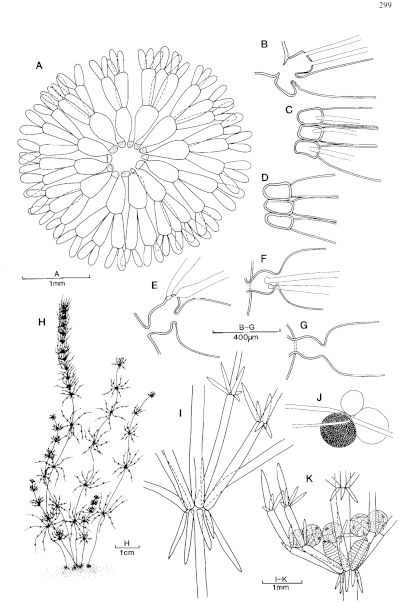|
|
|
|
|
|||||||||||
|
Electronic Flora of South Australia Species Fact Sheet
Phylum Charophyta
Selected citations: Wood 1965: 330; 1972: 37. Wood & Imahori 1964: figs 162, 165. Delroy 1974: 157. Ducker, Brown & Calder 1977: 59.
Thallus (Fig. 102H) monoecious, usually 5–30 cm high, not or slightly encrusted, ecorticate. Axes 200–800 µm in diameter, internodes usually 1–4 cm long. Branchlets 6–8 in a whorl, 0.5–2 cm long, of 3–5 segments. Stipulodes (Fig. 102I) in one tier, opposite, decumbent, 1–3 mm long. Bract-cells (Fig. 102I) 3–5, few at distal nodes, verticillate, 500–1000 (–2000) µm long. Gametangia (Fig. 102K) adjacent at 1 (–2) lowest branchlet nodes; oogonia 600–1500 µm long, with 10–15 convolutions, coronal cells 90–135 µm high; antheridia 300–500 µm in diameter. Bulbils (Fig. 102J) occasional on lowest axial nodes or rhizoids, 500–1500 µm in diameter.
Type from Germany (see Wood 1965, p. 336).
Selected specimens: West Lakes, S. Aust., on W. side, 2–2.5 m deep (Thomas, 22.xii.1975; ADU, A46755). Coorong, S. Aust., in shallow water about 40 km S. of Meningie ( Womersley, 15.ix.1970; maintained in culture, ADU, A54177). Coorong, S. Aust., about 25 cm deep, 13 miles (about 21 km) S.E. of Salt Creek ( Wood 60–9–22–1 & von der Borch, 22.ix.1960; ADU, A38939).
Distribution: Widespread, especially in coastal regions, of Europe, Africa, China, Australasia.
In southern Australia, known from "marine" habitats in West Lakes and the Coorong, S. Aust., and the Gippsland Lakes, Vic.
Taxonomic notes: Lamprothamnium papulosum is reported by Delroy (1974) to be a food of waterfowl in the Coorong, where in hypersaline conditions it produces starch bulbils (on which the birds feed). It was found to be widespread in the summers of 1956–66 and 1971–72 in the southern Coorong, but poorly developed in 1970–71 when salinity was high. It does not grow satisfactorily at salinity of over 60‰.
Ducker, Brown & Calder (1977, pp. 36, 60) report L. papulosum from Lake Reeve, Victoria, where salinity ranges between 10 and 104‰ are reported, and from Bunga Arm of Lake King and Lake Tyers with salinities between 6 and 16‰. It seems clear that in such areas as the Coorong and the above Gippsland Lakes in southern Australia that L. papulosum can exist and grow reasonably well in the salinities of sea water and possibly above. Cultures have been maintained for several years in the Department of Botany, University of Adelaide in salinity of about 28‰, with Polyphysa peniculus growing well in the same cultures.
References:
DELROY, L.B. (1974). The food of waterfowl (Anatidae) in the southern Coorong saltwater habitat of South Australia. J. S. Aust. Ornithol. Ass. 26, 157–163.
DUCKER, S.C., BROWN, V.B. & CALDER, D.M. (1977). An identification of the aquatic vegetation in the Gippsland Lakes. Environmental Studies series No. 136. (Ministry for Conservation: Melbourne.)
WOOD, R.D. & IMAHORI, K. (1964). A revision of the Characeae. Part II. Inconograph of the Characeae. (Cramer: Weinheim.)
WOOD, R.D. (1965). A revision of the Characeae. Part. I. Monograph of the Characeae. (Cramer: Weinheim.)
WOOD, R.D. (1972). Characeae of Australia. Nova Hedwigia 22, 1–120.
The Marine Benthic Flora of Southern Australia Part I complete list of references.
Publication:
Womersley, H.B.S. (31 May, 1984)
The Marine Benthic Flora of Southern Australia
Part I
©Board of the Botanic Gardens and State Herbarium, Government of South Australia
Illustration in Womersley Part I, 1984: FIG. 102 H–K.

Figure 102 enlarge
Fig. 102. A. Dasycladus densus (ADU, A19437), cross section of thallus; all walls between segments arc perforate. B–D. Acetabularia calyculus (ADU, A33400). B. Sectional view of gametangial ray with superior corona (bearing 2 hairs) and inferior corona. (After Womersley 1971, Fig. 15.) C. Superior corona with hairs, from above. D. Inferior corona, from below. E–G. Polyphysa peniculus (ADU, A54173). E. Sectional view of base of gametangial ray with superior corona (bearing 2 hairs) and slight bulge of inferior corona. F. Superior corona with two hairs, from above. G. Base of gametangial ray, from below. H–K. Lamprothamnium papulosum (ADU, A54177, from culture). H. Habit of thallus. I. Nodal branching with opposite stipulodes and bracts on two lateral branches. J. Starch bulbils on rhizoids, from muddy substrate. K. Part of fertile spike with antheridia on first node of branchlets and oogonia (two only shown) at base of whorl.

|
Email Contact: State Herbarium of South Australia |

|